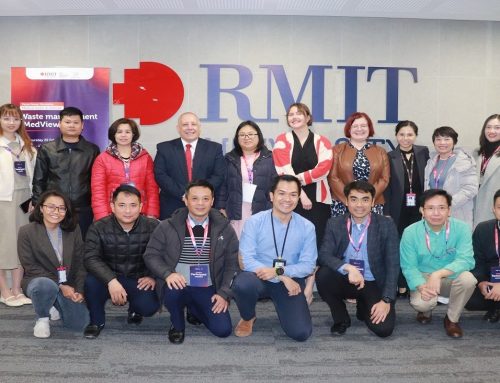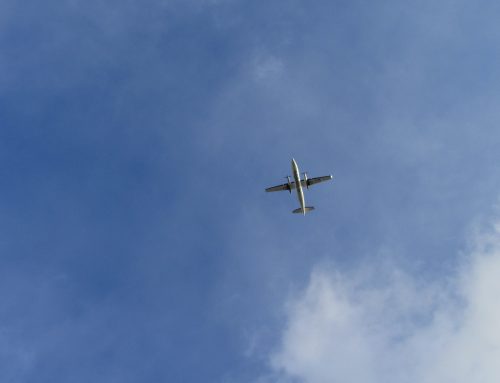An earthquake hits or a tsunami washes over land and another town lies in ruins. Among the devastation sniffer dogs scramble nose down over rubble to find the dead and injured. But what if we could harness animals not only to rescue but also to heal the injured? Frank Stadler and colleagues from Griffith University say that the humble blowfly can assist first responders and healthcare providers in the treatment of wounds and prevent infection in austere environments.
The international spotlight during humanitarian crises is always firmly fixed on casualty scores, the need for food and shelter, and on communicable diseases such as diarrhoea and malaria. However, crises like earthquakes, civil unrest and general poverty invariably result in far greater numbers of people being injured than killed. Wound care under austere conditions is challenging and as a consequence necrosis, wound infection and debilitating chronic wounds are common. Here we outline how Maggot Debridement Therapy (MDT), the use of living fly larvae for the treatment of problem wounds, can assist first responders and medical aid agencies in the provision of highly efficacious wound care and clinical decision making in resource constrained healthcare environments.
There are mainly three areas in humanitarian and emergency medicine where Maggot Debridement Therapy could be deployed with great promise:
- in the event of natural disasters such as earthquakes and tsunamis;
- in response to man-made mass disasters, including industrial accidents, explosions, transport disasters, and terrorism; and
- in developing nations where healthcare systems are unable to provide effective acute and chronic wound care.
To our knowledge, however, there has not been any routine use of Maggot Debridement Therapy in humanitarian medical aid despite its obvious utility. Medical maggots are highly selective and efficient micro-surgeons that, when introduced to a wound with lots of damaged tissue, will only feed on and remove the dead tissue outperforming surgical sharp removal of dead tissue with the scalpel. While medical maggots are busy cleaning the wound they also suppress and fight infection including those pathogens resistant to antibiotics. If that wasn’t enough, there is now good evidence that medical maggot digestive excretions also stimulate healing and tissue regeneration.
This triple action should make medical maggots a therapy of choice after disasters when a large number of patients need to be treated and when timely prevention of infection is of the essence. Because medical maggots perform the task of surgeon, antibiotic and growth factor, they should be also the preferred method of wound care in developing nations where healthcare providers do not have access to many skilled surgeons nor modern wound care technology and advanced dressings.
So, if Maggot Debridement Therapy is such a good idea, why is it not widely used? Firstly, in the conservative world of medicine, the revival of MDT is still a very new phenomenon even though medical maggots have been used extensively to treat wound and bone infections in the 1930s and 40s. Besides, fly maggots are traditionally associated with death and decay and many medical practitioners are introduced to fly maggots when they encounter a patient with accidental infestation of wounds, many times as a result of unsanitary living conditions. So, there is a perception problem on behalf of medical practitioners often referred to as the ‘yuk factor’ that still needs to be overcome. Interestingly, patients have more positive attitudes and are far less concerned with medical maggots in their wounds. Secondly, there are logistic constraints that have prevented the therapy from implementation in the field. Even strong proponents of MDT in the modern clinical setting have shied away from exploring what is required to make MDT available in austere environments.
While breeding of medical flies is relatively easy, quality control and sterility of medical maggots is of utmost importance and this demands sophisticated laboratory and insectary facilities and trained operators. Medical maggots have a very short shelf life and will need to be dispatched and applied to the wound within approximately 48 hours at 6-25o C. This demands reliable and efficient cool chains connecting producer with patient, which can be extremely challenging after disasters or in Low- and Middle-Income Countries when transport and other infrastructure is damaged or unreliable. At the treatment end, practitioners need to be open to, and trained in, the use of MDT to maximise its benefits.
Research to date confirms the clinical potential for MDT in humanitarian aid and emphasises the central role of effective and efficient supply chain management. Key considerations are where to produce medical grade maggots; how to facilitate timely dispatch; what reliable and effective distribution networks look like; and what the social enablers and barriers to the deployment of MDT in humanitarian aid are? World-first research is under way at Griffith University to address these issues.
Poor wound care in compromised healthcare settings is still responsible for much suffering, permanent disability and death. The humble blowfly stands ready to be of service but a concerted R&D effort is needed to overcome technical and social barriers before MDT can be operationalized in humanitarian aid.

Lucilia sericata, the most commonly used blowfly for MDT (© Stephen Doggett, Department of Medical Entomology, Westmead Hospital, Australia)

Rescue officers search through ruins after Wenchuan earthquake, named after the location of the epicenter in China. © 2008 Qiang Chen, Courtesy of Photoshare

An elderly couple in India sit next to a box of their remaining belongings after the 2004 Asian Tsunami. © 2004 Srikrishna Sulgodu Ramachandra, Courtesy of Photoshare
– <span style='font-size:12.0pt;font-family:"Arial",sans-serif;
mso-fareast-font-family:Calibri;mso-fareast-theme-font:minor-latin;mso-ansi-language:
SV-FI;mso-fareast-language:SV-FI;mso-bidi-language:AR-SA’>Mr Frank Stadler and Prof Peter Tatham and Prof Ramon Shaban Griffith University<span style='font-size:12.0pt;font-family:"Arial",sans-serif;
mso-fareast-font-family:Calibri;mso-fareast-theme-font:minor-latin;mso-ansi-language:
SV-FI;mso-fareast-language:SV-FI;mso-bidi-language:AR-SA’>
<span lang="EN-AU" style='font-size:11.0pt;line-height:110%;font-family:"Arial",sans-serif;
mso-fareast-font-family:Arial;background:white;mso-ansi-language:EN-AU;
mso-fareast-language:EN-US;mso-bidi-language:AR-SA’ xml:lang=”EN-AU”>Frank Stadler<span lang="EN-AU" style='font-size:11.0pt;line-height:110%;font-family:"Arial",sans-serif;
mso-fareast-font-family:Arial;background:white;mso-ansi-language:EN-AU;
mso-fareast-language:EN-US;mso-bidi-language:AR-SA’ xml:lang=”EN-AU”> <span lang="EN-AU" style='font-size:11.0pt;line-height:110%;font-family:"Arial",sans-serif;
mso-fareast-font-family:Arial;background:white;mso-ansi-language:EN-AU;
mso-fareast-language:EN-US;mso-bidi-language:AR-SA’ xml:lang=”EN-AU”>has a long-standing interest in Maggot Debridement Therapy and is currently pursuing doctoral research at the Department of International Business and Asian Studies at Griffith University. His research is concerned with the characteristics of medical supply chains in compromised healthcare settings to understand the opportunities and barriers for the delivery of Maggot Debridement Therapy in humanitarian aid. He is a biologist with a varied career in museum and arts curation, science communication, and research coordination. At the National Climate Change Adaptation Research Facility he coordinated a multi-million dollar portfolio of climate change adaptation research. In his spare time he continues his engagement with climate change adaptation as an Adjunct Research Fellow at the Department of International Business and Asian Studies exploring how biological adaptation can inform societal adaptation to climate change. Contact: <span lang="EN-GB" style='font-size:10.0pt;mso-bidi-font-size:11.0pt;line-height:110%;font-family:
“Arial”,sans-serif;mso-fareast-font-family:Arial;mso-bidi-font-family:”Times New Roman”;
mso-ansi-language:EN-GB;mso-fareast-language:EN-US;mso-bidi-language:AR-SA’ xml:lang=”EN-GB”><span lang="EN-AU" style="font-size:11.0pt;
line-height:110%;mso-bidi-font-family:Arial;background:white;mso-ansi-language:
EN-AU” xml:lang=”EN-AU”>f.stadler@griffith.edu.au<span lang="EN-AU" style='font-size:11.0pt;line-height:110%;font-family:"Arial",sans-serif;
mso-fareast-font-family:Arial;background:white;mso-ansi-language:EN-AU;
mso-fareast-language:EN-US;mso-bidi-language:AR-SA’ xml:lang=”EN-AU”>, +61(0)422731540
Professor Ramon Shaban is an internationally respected clinician, educator and researcher. His expertise infection control and emergency care are the basis of a highly successful and integrated program of teaching, practice, and research. He is Clinical Chair and Professor of Infection Prevention and Control at Griffith University and the Gold Coast Hospital and Health Service, Australia. As Director of the Griffith Graduate Infection Prevention and Control Programs at Griffith University he is an active member of variety of professional groups and committees including the Australian Strategic and Technical Advisory Group on Antimicrobial Resistance, President of the Australasian College for Infection Prevention and Control, Editor-in-Chief of the Australasian Emergency Nursing Journal, Senior Editor of Infection, Disease and Health, and Temporary Advisor (Antimicrobial Resistance) to the World Health Organization Western Pacific Region.
<span lang="EN-GB" style='font-size:11.0pt;line-height:
110%;font-family:”Arial”,sans-serif;mso-fareast-font-family:Arial;color:black;
mso-ansi-language:EN-GB;mso-fareast-language:EN-US;mso-bidi-language:AR-SA’ xml:lang=”EN-GB”>A former (UK) Royal Navy logistician, Professor Peter Tatham is a global expert in the field of humanitarian logistics and is Professor of Humanitarian Logistics at Griffith University, Queensland, Australia where he is a member of the <span lang="EN-GB" style='font-size:10.0pt;mso-bidi-font-size:11.0pt;line-height:110%;font-family:
“Arial”,sans-serif;mso-fareast-font-family:Arial;mso-bidi-font-family:”Times New Roman”;
mso-ansi-language:EN-GB;mso-fareast-language:EN-US;mso-bidi-language:AR-SA’ xml:lang=”EN-GB”><span style="font-size:11.0pt;line-height:110%;mso-bidi-font-family:Arial;color:black;
text-decoration:none;text-underline:none”>Griffith Asia Institute<span lang="EN-GB" style='font-size:11.0pt;line-height:110%;font-family:"Arial",sans-serif;
mso-fareast-font-family:Arial;color:black;mso-ansi-language:EN-GB;mso-fareast-language:
EN-US;mso-bidi-language:AR-SA’ xml:lang=”EN-GB”> and <span lang="EN-GB" style='font-size:10.0pt;mso-bidi-font-size:11.0pt;line-height:110%;font-family:
“Arial”,sans-serif;mso-fareast-font-family:Arial;mso-bidi-font-family:”Times New Roman”;
mso-ansi-language:EN-GB;mso-fareast-language:EN-US;mso-bidi-language:AR-SA’ xml:lang=”EN-GB”><span style="font-size:11.0pt;line-height:110%;mso-bidi-font-family:Arial;color:black;
text-decoration:none;text-underline:none”>Urban Research Program<span lang="EN-GB" style='font-size:11.0pt;line-height:110%;font-family:"Arial",sans-serif;
mso-fareast-font-family:Arial;color:black;mso-ansi-language:EN-GB;mso-fareast-language:
EN-US;mso-bidi-language:AR-SA’ xml:lang=”EN-GB”>. His research interests include: humanitarian logistics; the management of agile supply networks; and defence logistics. Professor Tatham is currently working with HKL Logistics on the use of Remotely Piloted Aircraft Systems (RPAS) in the achievement of post-disaster needs assessment and resupply activities, in the use of 3D Printing to improve Water, Sanitation and Hygiene (WASH) programs, and in the development of supply chains to support the use of ‘medical maggots’<span lang="EN-GB" style='font-size:11.0pt;line-height:110%;font-family:"Arial",sans-serif;
mso-fareast-font-family:Arial;background:white;mso-ansi-language:EN-GB;
mso-fareast-language:EN-US;mso-bidi-language:AR-SA’ xml:lang=”EN-GB”>.<span lang="EN-GB" style='font-size:11.0pt;line-height:110%;font-family:"Arial",sans-serif;
mso-fareast-font-family:Arial;mso-bidi-font-family:”Times New Roman”;
mso-ansi-language:EN-GB;mso-fareast-language:EN-US;mso-bidi-language:AR-SA’ xml:lang=”EN-GB”>




